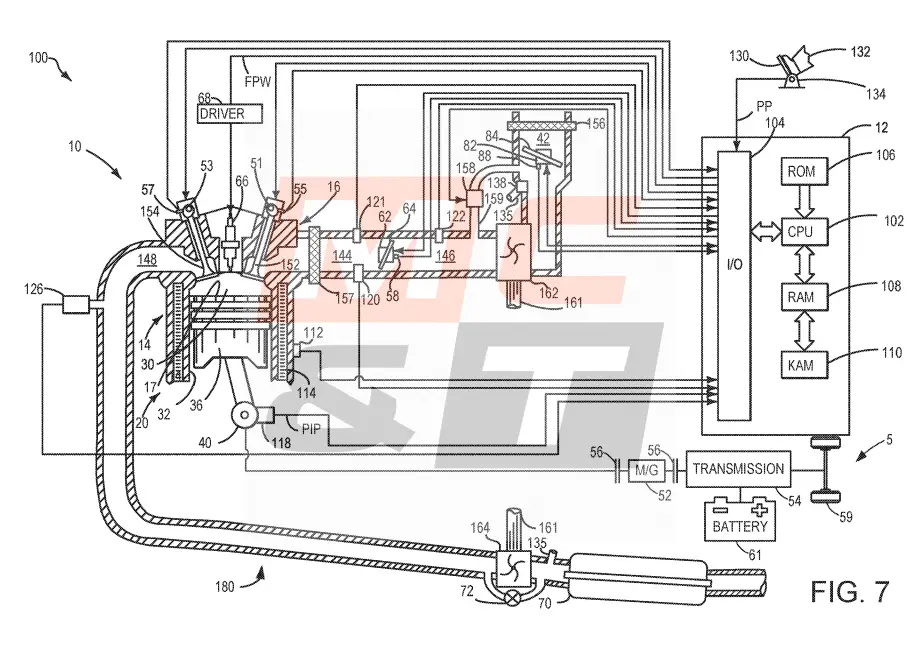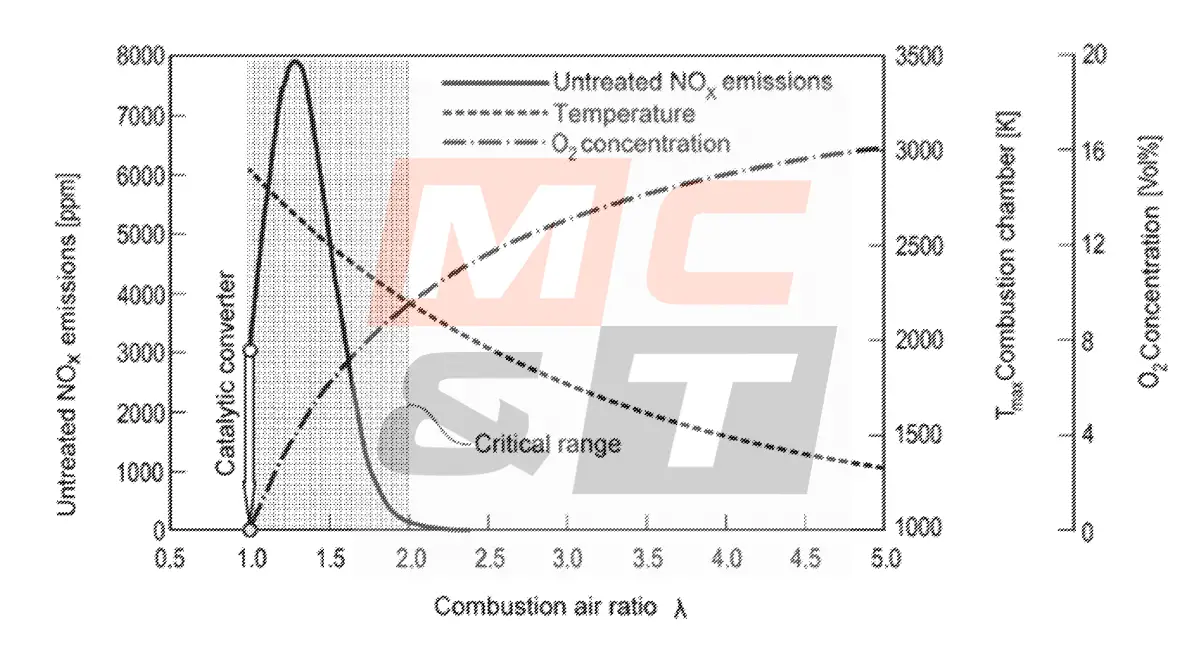Over the past 24 months, Ford Motor Company has made big commitments to the future of its battery-electric vehicle business. The company announced demand-driven production bumps for its two BEVs, the Mustang Mach-E and the incoming F-150 Lightning pickup truck. Plans for two battery factories in Kentucky and one in Tennessee were detailed, alongside a BEV mega campus in Tennessee. Even more significant, the company plans an internal restructuring separating the internal combustion and electric vehicle programs into respective silos. Amidst all the high-profile BEV news, Ford engineers have been quietly exploring ways to keep the internal combustion side of the business healthy, including a new method of hydrogen combustion.
Discovered by MC&T within the U.S Patent and Trademark Office database, Ford has created a method of combustion allowing a turbocharged hydrogen-fueled engine to operate across a wide range of air/fuel lambda values depending on torque demands. Internal exhaust gas recirculation (EGR) and valve timing would be used to control combustion.
Lambda is the Greek letter used to represent a fuel’s stoichiometric value as 1.00. The stoichiometric value of a fuel is the ratio by which all of the fuel is combined with all of the oxygen to produce a complete burn. Gasoline engines have a stoichiometric value of 14.7:1, meaning 14.7 parts of air to 1 part gasoline equals a lambda of 1. Lean combustion is represented as a value higher than 1.00, while richer mixtures are shown as less than 1.00.
For the most part, a gasoline engine can operate in a range from 8:1 at the richest to 18.5:1 at the lean end of the spectrum. Lambda is calculated by diving the air/fuel ratio into the stoichiometric value of the fuel–so the richest gasoline combustion mixture is represented as 0.54 lambda, while the leanest is 1.25 lambda. Ford’s new method of turbocharged hydrogen combustion looks to explore lambda values in excess of 2.00. Meaning the engine would be capable of operating in an extremely lean state, using more than double the amount of air required for the stoichiometric combustion of hydrogen.

Available data indicates hydrogen’s stoichiometric value is in the 34:1 range, so if Ford is running hydrogen combustion at a Lambda of 2.00 or beyond that means the engine has an air/fuel mix of at least 68 parts air to 1 part hydrogen. For what it’s worth, Mike Copeland’s hydrogen converted LS engines are running at 100:1 with the help of a supercharger. Hydrogen is capable of combusting at such lean air/fuel mixtures because of the fuel’s low impedance to ignition. At stoichiometric values hydrogen has an extremely fast flame speed, it’s described as roughly an order of magnitude faster than gasoline. The increased flame speed means there is a much greater chance of detonation, however, if the mixture is leaner, the flame speed is reduced.
For Ford’s method of hydrogen combustion to work the hydrogen would be introduced via direct injection, allowing fuel and air to be controlled independently of one another compared to using port injection, which mixes the air/fuel upstream of the combustion chamber. Supplied using DI, hydrogen is capable of providing 15% more power than gasoline.
Using a constant fuel input, the amount of EGR can be altered to move the post-combustion lambda value from 1.00 all the way to 2.00 or above. Under higher torque demands when the mixture is richer in hydrogen, EGR flow would be increased to reduce the temperature within the combustion chamber, thus reducing the chance of pre-ignition. This is true because the recirculated exhaust gas enrichens the hydrogen mixture by displacing the air that would normally be present in the chamber. Remember, a combustion engine creates maximum power from a slightly rich air/fuel mixture, while a leaner mixture is better for fuel economy. A lean mix fundamentally contains less fuel than a richer one. When torque demands are lower and the hydrogen engine is running leaner, less EGR would be provided.

According to the patent, the EGR content could be altered by shifting the valve timing or by introducing significant overlap. Ford is looking at a “multi-lift profile” where “the inlet valve performs two mutually independent valve strokes during one working cycle.” This could be achieved via “a second valve stroke being performed before the actual valve stroke of the inlet valve.” All of this would be controlled by a fully variable valve controller capable of altering the duration and valve stroke.
Lastly, Ford claims the hydrogen combustion engine could be part of a hybrid powertrain. The example shown includes a motor-generator unit placed in series between the engine and the transmission, but Ford claims it could be used in a parallel, a series, or a series-parallel hybrid vehicle. Pairing a hydrogen combustion method using extremely lean air/fuel mixtures with a motor-generator is advantageous because the energy density of a hydrogen-air mixture at lambda values in excess of 2.00 is extremely low compared to stoichiometric.

Keep in mind, Ford’s patent only covers the method of combusting and controlling hydrogen mixtures. More work would have to be done to create an engine design capable of optimizing this method. The shape of the combustion chamber and the top of the piston have a significant influence on combustion, and both would have to be shaped to take advantage of hydrogen’s unique combustion properties.
Most promising though, hydrogen can take advantage of a hugely oversquare bore-to-stroke ratio because unburned hydrocarbons aren’t a concern, parasitic losses are also reduced using a short-stroke design. This means engines capable of screaming to 20,000 rpm could be possible in a regular grocery-getter, reversing the current trend of characterless under square engines.






hydrogen car with fuel cell is born dead.
combustion hydrogen car half as efficient even more
What’s your metric for efficiency?
if you compare fuel cell hydrogen to hydrogen combustion engine, I’d say mechanical energy output by the motor as percentage of the chemical energy held by H2
But when comparing electric to hydrogen (fuel cell or not), the only fair way to compare is from grid/solar panel electric energy, to hydrogen, to the wheels, vs grid to battery to the wheels. I don’t see the point in setting up hydrogen production/storage/transport/cars if it’s using fossil fuel to produce H2..if zero C02 it could work temporarily
but BEV efficiency >> fuel cell efficiency >> hydrogen combustion efficiency
For Light-Duty Passenger Vehicles, EVs blow both H2/FC and H2/ICE completely out of the water on a wire-to-wheels efficiency basis. Hydrogen by any means for LDPVs is a non-starter. Probably for all other transportation applications as well.
Advanced Biofuels also beat H2, but they are lagging in Technology Readiness Level. Also, the sustainable TOTAL ENERGY from ABFs is far, far lower than from renewable electricity, so those likely will be better reserved for the things that electricity (and hydrogen) cannot do well (air, marine, long-haul freight).
The energy required to manufacture a battery capable of 250 miles produces roughly 65-70 percent more emissions compared to ICE. That figure DOES NOT include the exploration, mining, and transport of several toxic rare earth metals to cell production and electrolyte facilities before transporting them once again to battery production facilities. Wire-to-Wheel efficiency metrics also ignore the motor production supply chain. These factors cannot be waved away as unimportant. We cannot ignore that these rare earth metals are limited and do their own damage.
(proper) Wire-to-wheels analyses do NOT ignore those factors. That is a myth, and standard disinformation from the Hydrogen Cult. It is such a tired lie it becomes wearying to keep refuting.
Lithium production also gobbles up 500,000 gallons of water per ton extracted. Lithium mining is just as unregulated as fracking is and that’s a huge elephant.
When we’re discussing hydrogen, the benefit is a localized production scheme that can capture hydrogen from simple processes like organic waste decomposition, and wastewater treatment. I’ll happy to trade some powertrain efficiency for a cleaner, localized supply chain any day of the week.
Hydrogen supply AT SCALE is never going to be localized. Sure, you can produce a small amount of hydrogen that way, but cities and suburbs, where most driving is done, don’t have anything like the capacity needed. You really will say ANYTHING to defend the indefensible, won’t you?
As for water, there are multiple technologies for its production, and of course you cite only the worst of them. Even at that rate, with 8 kg of Li in a typical EV, that’s 4,000 gal. per vehicle. Gasoline, by contrasts, takes 1.5 gal. of water per gal. of gas to produce. THOUSANDS of gallons over the car’s life.
You moved the goalposts hoping no one would notice, it’s cute. We are not talking about gasoline. Fukuoka City in Japan is already doing all of the things you claim are never going to happen, you can’t just say NEVER and hope to be taken seriously. In your model what’s the localized capacity needed, what’s the localized capacity available, what do you have to offer other than your feelings?
Hydrogen by electrolysis consumes 9 kg of water per kg H2. 1 kg H2 is about equivalent to 1 gal. of gasoline, so that’s the equivalent of 2.4 gal. water per gal. gasoline equivalent — even worse than petroleum & gasoline. And that’s just what is consumed for electrolysis. Depending on the rest of the value chain, lots more water can be consumed as cooling water.
You do love to pick and choose your “facts,” don’t you?
Hoisted by your own petard. Why are you bringing gasoline into this, we’re not talking about gasoline production, we’re moving away from fossil fuels, remember? See, the problem with the lithium industry’s use of water is that it straight-up poisons the groundwater, making it utterly worthless to anything or anyone. And we haven’t even begun to talk about the mining required to harvest the other key battery metals required. The same place you found your hydrogen debunking facts also says hydrogen electrolysis uses 70% less water than agriculture, and 33% less water than is currently used f
You seem to have shut off replies to your nonsense. No surprise. You have faith, not facts. Hydrogen is a dead end.
I’m sure your perspective is smarter and more insightful than all of the engineers literally making hydrogen happen.
water is renewable unlike fossil fuel
But water has zero useful energy content, and hydrogen is an absolutely HORRIBLE material to try to store and transport at the scales required for the energy markets.
how likely does it sound to power all cars with H2 from waste ? we need a game plan to replace all fossil fuel, and mixing h2 and battery EV’s sounds even more complex than converting everything to bev. easier to transport electricity than H2. for the price of one H2 pump you can build dozens of EV chargers. plus potentially every EV could have some sort of residential charging (private or public). it is much more realistic than storing /producing h2 at home.
anyway people living in cities/condos don’t need 1 charger / car. they don’t have 3h /200miles commute
Why is it unlikely? Humans are constantly producing an abundance of waste, in particular, cellulose-heavy waste is particularly well suited to hydrogen production. Electricity production produces just as much greenhouse gas as the ENTIRE transportation industry, and that includes commercial shipping and air travel. Sadly, natural gas and coal extraction, which the U.S. relies on heavily for electricity generation are both significant sources of methane gas, methane is 25x more potent as a greenhouse gas than C02. If we want to save this planet we need to go further than destroying the planet t
Geemy – You clearly didn’t read the article. It’s talking about direct injection of hydrogen, not a fuel cell.
Looks like you didn’t read the reply. It also contained:
“. . . combustion hydrogen car half as efficient even more.”